“UNDERSTANDING THE DYNAMICS OF CEASEFIRE NEGOTIATIONS BETWEEN ISRAEL AND HAMAS”
Syllabus:
- GS-2 :Terrorist organizations, role of non state actors, World peace and security Bilateral relation of India with other countries
Focus :
- This article examines the complexities surrounding the ceasefire negotiations between Israel and Hamas, highlighting the motivations and challenges faced by both parties.
- It delves into the role of mediators, the stance of key players, and the implications of potential outcomes on regional stability and domestic politics.
Source - AJ
Introduction:
- Israel and Hamas engage in ceasefire negotiations amid ongoing conflict.
- Mediation efforts by the United States and allies to broker a deal.
- Analysis of key players, motivations, and challenges in reaching a ceasefire agreement.
Mediation Efforts:
- Involvement of Diplomatic Channels:United States, along with allies Qatar, Egypt, Jordan, and Saudi Arabia, actively involved in mediation.
- Meetings held in various locations including Cairo, Doha, Tel Aviv, and Riyadh to negotiate terms.
- Arab and American mediators striving for a mutually acceptable agreement between Benjamin Netanyahu and Yahya Sinwar of Hamas.
Role of Qatar as Chief Mediator:
- Qatar plays a central role in hosting negotiations and facilitating dialogue between the conflicting parties.
- Efforts focused on securing the release of Israeli hostages by Hamas and a ceasefire agreement from Israel.
- Frustration expressed by Qatar over lack of cooperation from both sides, leading to shifts in mediation efforts.
Shift to Egyptian Mediation:
- Negotiations transition from Doha to Cairo, with Egypt taking over as the mediator.
- Tripartite mediation efforts involving the United States, Egypt, and Qatar persist in seeking a breakthrough.
- Despite challenges, mediators strive to keep negotiations alive to achieve a ceasefire deal.
Motivations and Concerns:
- Benjamin Netanyahu’s Priorities:Netanyahu’s immediate concerns extend beyond the release of hostages to avoid an arrest warrant from the International Criminal Court.
- Political implications for Netanyahu’s government influence stance on ceasefire negotiations.
- Potential reluctance towards a ceasefire due to internal political dynamics and concerns over public perception.
Hamas’ Strategic Calculations:
- Hamas appears to adopt a tough stance on ceasefire negotiations, possibly leveraging perceived gains from the conflict.
- Leadership, including Yahya Sinwar, focuses on strategic objectives and maintaining leverage in negotiations.
- Hamas’s willingness to continue conflict despite potential humanitarian crises indicates broader strategic considerations.
Hamas:
|
Challenges to Ceasefire Agreement:
- Complexities arise from conflicting interests and perceptions of victory on both sides.
- Netanyahu’s government and some cabinet members express reluctance towards ceasefire, preferring continued conflict.
- Internal and external pressures from various stakeholders pose challenges to reaching a consensus on ceasefire terms.
Analysis of Hamas’ Strategy:
- Hamas’ Perceived Victories:Hamas leadership views conflict outcomes as a victory for the organization, despite significant humanitarian costs.
- Strategic failures by Israel contribute to Hamas’ confidence in maintaining its stance on ceasefire negotiations.
- Utilization of perceived victories to bolster support and legitimacy among Palestinian populations.
Yahya Sinwar’s Role and Influence:
- Sinwar, as the mastermind behind attacks and a key figure in Hamas leadership, plays a crucial role in decision-making.
- Focus on strategic objectives and long-term goals guide Sinwar’s approach to ceasefire negotiations.
- Utilization of international support and sympathy towards Palestinian cause to bolster Hamas’ position.
International Perceptions and Reactions:
- Global Reaction to Conflict:International reactions vary, with some condemning Israeli actions while others express support for Israel’s right to defend itself.
- Increased scrutiny on Israel’s military operations and potential violations of international law.
- Humanitarian concerns raised over the impact of conflict on civilian populations in Gaza.
Implications for International Relations:
- Conflict exacerbates tensions in the region and impacts broader geopolitical dynamics.
- Role of international actors in mediating conflicts and promoting peaceful resolutions highlighted.
- Potential consequences for regional stability and security emphasized by international stakeholders.
Domestic Dynamics in Israel:
- Public Opinion and Political Landscape:Diverse opinions within Israeli society regarding the government’s handling of the conflict and ceasefire negotiations.
- Public support for ceasefire agreements reflects growing concerns over the humanitarian crisis in Gaza.
- Netanyahu faces pressure from various quarters, including public protests and think tanks advocating for peaceful resolutions.
Government Response and Decision-making:
- Netanyahu’s government balances domestic and international pressures in determining its stance on ceasefire negotiations.
- Considerations of political repercussions and public sentiment influence government decisions.
- Internal debates within the cabinet highlight divergent views on the appropriate course of action.
Prospects for Ceasefire and Beyond:
- Potential Outcomes of Ceasefire Negotiations:Ceasefire agreement holds the promise of relief for civilian populations and the release of hostages.
- Uncertainty persists over the durability of ceasefire arrangements and the ability of both parties to adhere to agreed terms.
- Humanitarian aid and reconstruction efforts may follow ceasefire agreements to address immediate needs in conflict-affected areas.
Long-term Solutions needed:
- Ceasefire negotiations represent a temporary respite in a protracted conflict with underlying political and territorial disputes.
- Broader peace-building efforts and diplomatic initiatives required to address root causes of conflict and achieve lasting peace.
- Role of international community in supporting peace processes and promoting dialogue emphasized for sustainable solutions.
Source:The Hindu
Associated article :
https://universalinstitutions.com/where-does-india-stand-on-israel-hamas-war/
Mains Practice Question :
GS-3
“Examine the dynamics of ceasefire negotiations between Israel and Hamas, analyzing the motivations, challenges, and implications for regional stability. Discuss the role of international mediators and domestic factors in shaping the outcome of the negotiations.” (250 words)




